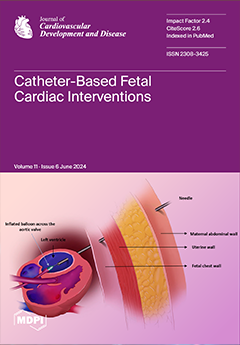We characterized the performance, as well as the safety, of a second-generation thin-strut sirolimus-eluting stent with a biodegradable polymer, Alex Plus (Balton, Poland), implanted in patients with type 2 diabetes (DM) with a 4-year follow-up. We defined the primary endpoint as the 48-month
[...] Read more.
We characterized the performance, as well as the safety, of a second-generation thin-strut sirolimus-eluting stent with a biodegradable polymer, Alex Plus (Balton, Poland), implanted in patients with type 2 diabetes (DM) with a 4-year follow-up. We defined the primary endpoint as the 48-month rate of major cardiovascular adverse events (MACE), including cardiac death, myocardial infarction (MI), or target lesion revascularization (TLR). The secondary endpoints were all-cause death, cardiac death, MI, and TLR rates at 12, 24, 36, and 48 months. We enrolled 232 patients in whom 282 stents were implanted, including 97 DM and 135 non-DM patients. The mean age of the DM patients was 69.5 ± 10.1 years and females accounted for 30% of the patients. DM patients had higher rates of arterial hypertension (97% vs. 88%,
p = 0.016), dyslipidemia (86% vs. 70%,
p = 0.005), prior MI (61% vs. 40%,
p = 0.002), prior PCI (65% vs. 50%,
p = 0.020), and prior CABG (14% vs. 5.9%,
p = 0.029). We recorded statistically significant differences for MACE (HR 1.85, 95% CI 1.01–3.41,
p = 0.046), cardiac death (HR 4.46, 95% CI 1.44–13.8,
p = 0.010), and MI (HR 3.17, 95% CI 1.10–9.12,
p = 0.033), but not for TLR, between DM and non-DM patients in terms of the analyzed endpoints at 4 years. Our study showed that Alex Plus was efficient and safe in a contemporary cohort of real-world DM patients undergoing percutaneous revascularization.
Full article






